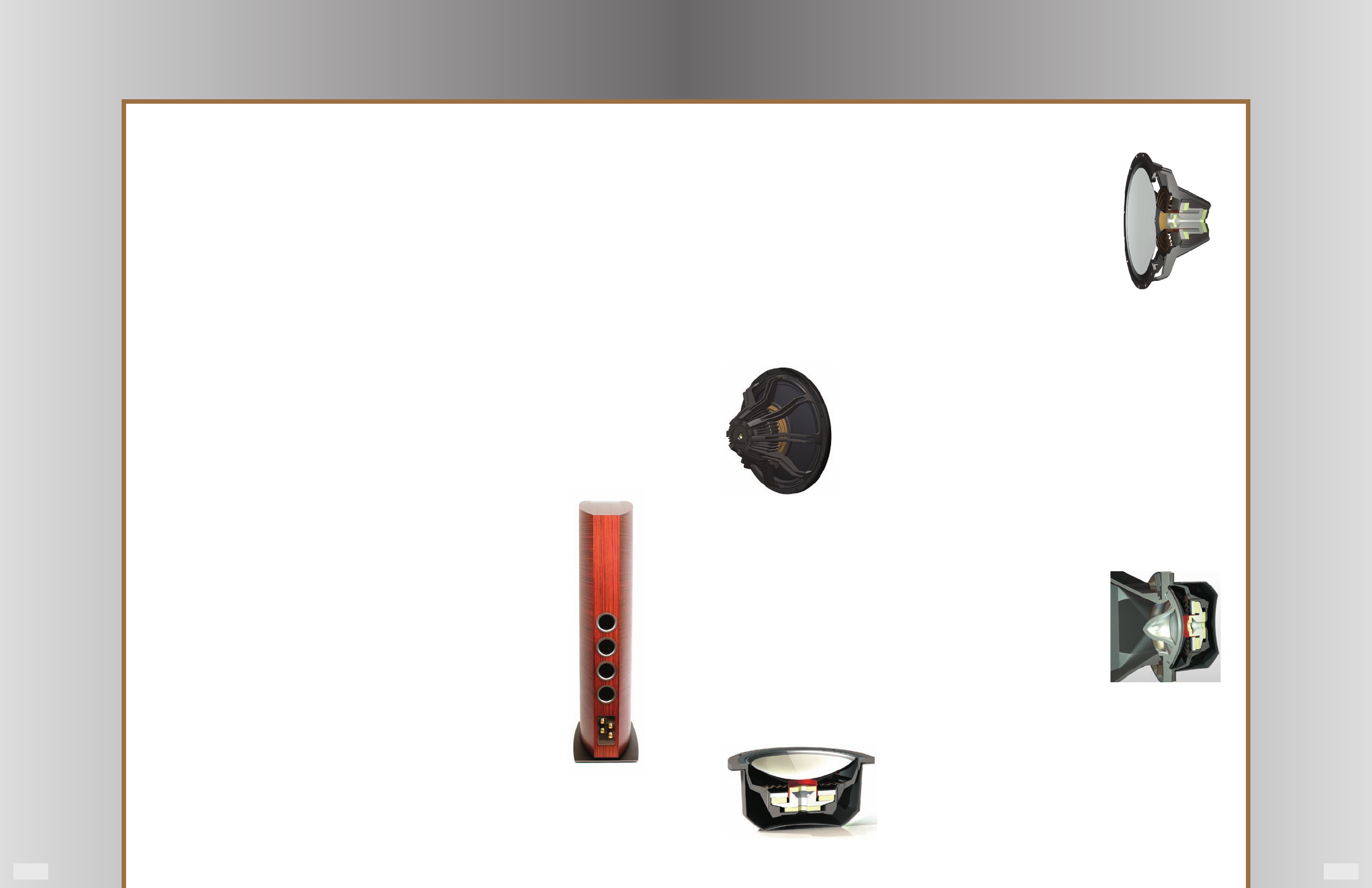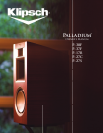
Page 14 Page 15
Loudspeaker Components -1About Your Loudspeaker
An International Project
The Klipsch Palladium Series has drawn on engineering, design and manufacturing resources from all over the
world. In addition to our formidable team in the USA, we have used European industrial designers, British theoreti-
cal physicists and manufacturing and production specialists from China.
The Palladium Series is the culmination of over 60 years of research and engineering advancements, having been
designed with the most advanced computer aided design (CAD) tools available, rigorously evaluated using our
own in-house proprietary software, built to the most stringent quality standards and voiced by a panel of our
most experienced listeners. No Klipsch loudspeaker has ever had more care and attention to every detail lavished
on it than your Palladium Series loudspeaker.
Although building one pair of loudspeakers is relatively straightforward, building hundreds of loudspeakers is
challenging. Measurements play an important role in analyzing loudspeaker characteristics, but the human ear
is the ultimate test gear for evaluating its reproduction quality . At Klipsch, every loudspeaker design is strictly
evaluated using listening tests designed to expose even the very smallest weakness. All nal voicing is performed
under blind conditions, using trained listeners and standard audio sound tracks selected based on their particular
area of auditory excellence. All information is tabulated and reported back to the designer for analysis. In almost
all cases, Klipsch products are evaluated against similarly priced competitive models. It is only in this manner that
Klipsch can truly rely on the quality of feedback received, eliminating skewed data that may result due to inu-
ences caused by price, brand recognition, or visual appeal.
Design
The P-38F, P-37F, P-17B and P-27C are 3.5-way bass-reex full range loudspeakers with high
sensitivity and extremely low distortion. The drivers consist of either 7-or 8-inch woofers, an
advanced 4.5-inch horn-loaded compression midrange driver, and a .75-inch titanium horn
loaded compression dome tweeter. Each driver was designed by the Klipsch Engineering
team and optimized for superior performance within each transducers bandwidth. Accu-
rate driver design minimizes the need for driver corrections in the crossover network. Thus,
the crossover is a straightforward design, with extremely high-quality components ensuring
minimal insertion loss. By presenting a simple load to the amplier, overall system perfor-
mance is enhanced, a phenomenon rarely found with conventional designs. Each compo-
nent used in the crossover, from the air core inductors to the polypropylene capacitors, has
been selected to provide an undistorted transition between transducers. The superior com-
ponents used in the Palladium Series is complemented by the unique horn and enclosure
design and highlighted by the elemental performance of the industrial design. The massive
laminated MDF enclosure is based on a curved non-parallel wall structure for minimal reso-
nance. Both the tweeter and midrange compression drivers are integrated into a common
molded two-element horn optimized for bandwidth, clarity, and eciency.
Bass Drivers
The woofer utilizes a low mass hybrid Aluminum/Rohacell®/Kevlar® cone with an over
hung voice coil. Even under massive dynamic demand, the driver retains linearity and
low distortion. A three-part high intensity neodymium magnet is used with a main
magnet, plus rear and forward magnets placed to ensure linearity, reduce stray magnetic
energy and provide intense eld strength in the voice coil gap. Dual Faraday rings on
the pole piece minimize unwanted inductance, enhance heat dissipation and minimize
dynamic compression.
The metal cone of the woofer is damped with a composite Rohacel and Kevlar layers,
which minimizes ringing and maintains low mass, eliminating breakup and other distor-
tion products. As is the case with the midrange driver, the surround uses a at-sided shape that keeps surround-
produced output to a minimum and preserves phase response. The cast aluminum frame assures maximum
heat transfer without any reection of the back wave of the driver that would otherwise alter the
sound. An inverted half-roll low density foam rubber surround completes the clean appear-
ance.
In the P-38F and the P-37F, he woofers see diering pass bands. This preserves con-
sistent dispersion through the critical woofer to midrange transition region and has a
positive impact on o-axis performance and stereo imaging. This upper woofer covers
the entire range from 30 Hz to 500 Hz, where it crosses over to the midrange driver,
while the two lower woofers cover only the low and mid-bass. This “tapered-array”
design delivers full bass impact, plus a graceful transition between driver groups in both
tonal accuracy and dispersion.
Midrange - “The midrange is where we live.” Paul W. Klipsch
The inverted dome midrange driver operates from 500 Hz to 3.5 kHz and is a unique design, not found on any
previous Klipsch product.
The driver sensitivity of 106 dB allows minimal excursion at normal playback volume.
As cone excursion reduces, so does distortion. The 4.5-inch aluminum dome is
driven by 3 high temperature N35H neodymium magnets, ensuring linearity under
a range of listening volumes. The pole piece is topped by a copper cap to minimize
unwanted inductive components. The surround has half the density of the material
typically used and thus oers reduced mass. Unlike most designs, this midrange
driver delivers much more output from the dome and less from the surround. As a
surround is always in motion and always changing shape, output from its surface is high in distortion—minimiz-
ing surround surface area is another means to reducing overall distortion.
The midrange unit is housed in its own magnetically-shielded sealed
enclosure, which isolates the driver from acoustic energy generated by the
woofers. Every eort has been made to ensure great accuracy, as well as
long-term durability from this unique driver.













